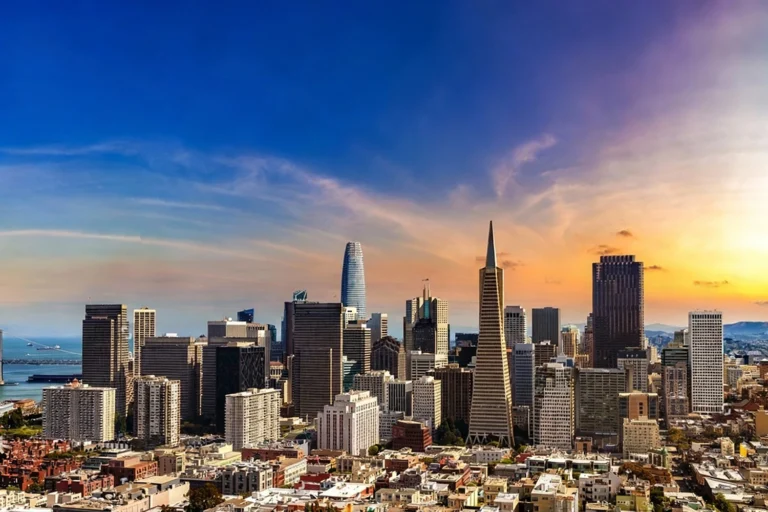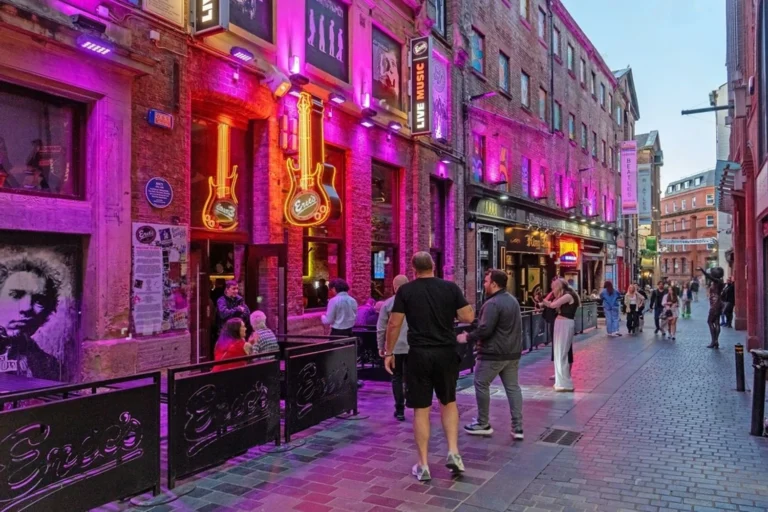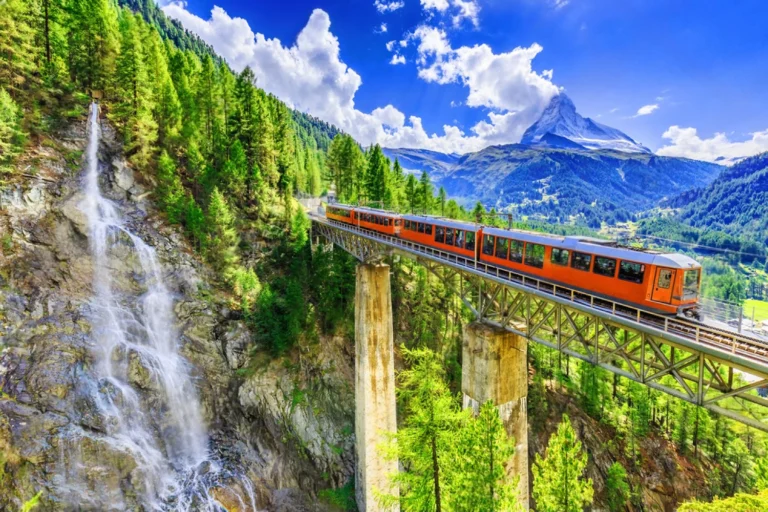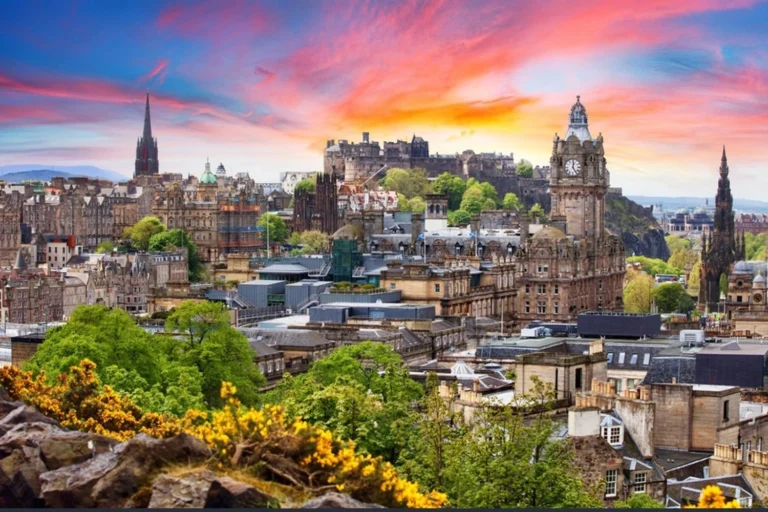Seoul: 30 Curious Facts Beyond the Neon and Noise

In Seoul, I learned to slow my gaze; the city is like a book whose margins hold the best notes. Between steam curling from a street pot and the soft glow pooling on rain dark stone at dusk, I kept stumbling into gentle, human moments. A nod at a doorway and a half heard joke on the train drew me past the glossy pictures. Walk with me into those overlooked corners, and we’ll notice textures beyond the postcards, the kind that reveal a deeper, quietly honest spirit.
https://en.wikipedia.org/wiki/Seoul
Where daily commutes turn into quiet gallery walks
I still smile thinking about the morning a platform corridor turned into a surprise gallery. The air was cool and a little metallic, the train’s low hum mixing with the shuffle of shoes. Paintings and photographs lined the tiled wall ink wash birds, a neon collage and people slowed without meaning to, shoulders softening in that hush before a curtain lifts. Down here, tucked under the city’s bright noise, art finds you between one stop and the next.
At one station, granite arches frame the platform while light installations send pale ripples across the floor, and every commute feels a touch cinematic like standing inside a lantern. It made me think of Seoul as a place that sneaks generosity into ordinary minutes, letting beauty catch you in transit. I stepped back into the day calmer, carrying a small glow I hadn’t planned on, the kind that lingers long after the doors slide shut.
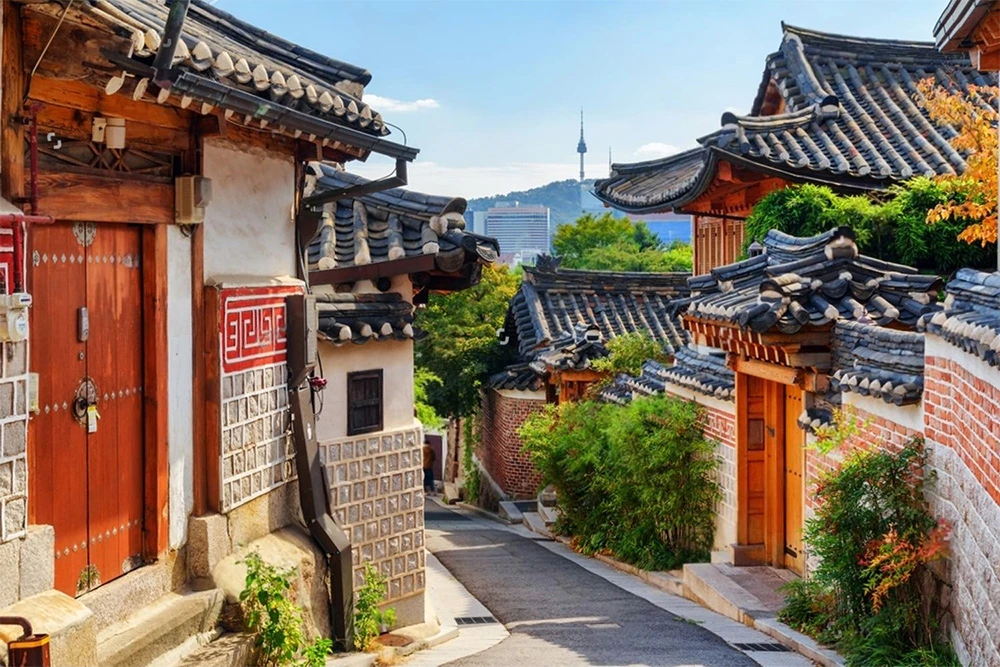
Five ton 'Host' monster by Yeouido's Han River.
I remember a picnic blanket, a plastic cup sweating in the evening air, and laughter drifting over the grass. Then the breeze shifted and there it was, the five ton creature hunched by the water, its skin catching the last light like a movie still that refused to end. People pointed, not scared so much as delighted another inside joke in the open air.
Only in Seoul would a creature from Bong Joon ho’s The Host be welcomed as public art. Families spread kimbap and fried chicken, someone inevitably cracks that it’s the strangest landmark a K‑cinema‑obsessed city could choose, and yet the mood is tender, almost proud. It feels like the river saying, yes, even our nightmares can sit with us awhile.
I like what it says about the place: we don’t bury our monsters; we give them a river view and let them cool their heels beside our ordinary evenings. The ferry lights blink on, kids chase each other through the grass, and the creature just watches odd, beloved, perfectly at home.
Where cafés surprise you at every corner
I never knew a latte could come with a bleat. At Thanks Nature Cafe, shaggy sheep nose around as if they own the place, their wool smelling faintly of hay while milk warms the air. I couldn’t stop grinning; there’s something about soft noses near table legs that relaxes the whole afternoon.
Then there’s the infamous Ddong Café, where poop is proudly on the menu: chocolate swirls shaped like the emoji, toilet shaped mugs, and the kind of laughter that melts away embarrassment. On a busy shopping street, I watched a robot glide by with steaming bowls of noodles, its arms steady while the broth scented the air with garlic and sesame. It felt like a gentle prank the city pulls to make sure you’re still awake to joy.
Every neighborhood seems to tuck away a new café surprise, so you start ordering whatever comes with a story and letting curiosity lead the palate. Somehow, Seoul turns coffee into theater, and the audience is whoever wandered in needing a small spark. I left each place calmer and a bit braver about being silly.
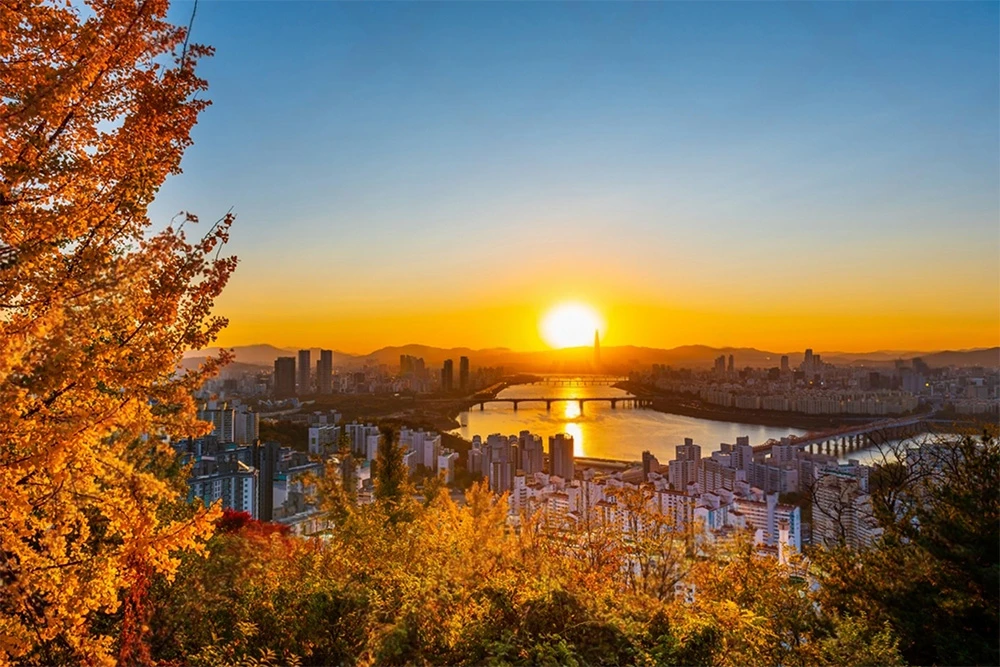
A secret room beneath the royal calm
I always imagined palaces kept their mysteries in glittering ceilings, but at Gyeongbokgung Palace I learned the quietest truths lie underfoot. Somewhere below the painted eaves is a hidden room where rulers once slipped away for private ceremonies and refuge. Thinking of it made the flagstones feel thinner, like polite smiles stretched over a quickened heartbeat. Even the air was cool and resin scented, wood and pine holding their own stillness.
Most people wander the courtyards and see only grandeur, not realizing they’re walking above blueprints for intrigue and escape. I love that hint of vulnerability kings and queens making room for fear, ceremony, and a plan B, as people do. In a busy city, there was a corner of quiet here for the moments when everything felt too loud.
I remember pausing by a shadowed corridor, aware of a steady purpose resting below my feet. Knowing about that hidden room made the place less monumental and more human grandeur on the surface, survival just beneath. It changed the way I moved, a little softer, grateful for the courage that quietly holds beauty together.
A forest of love locks on Namsan
The wind made them chime like tiny bells, a restless chorus of metal hearts. Fences, poles, even the shy trees seemed to be wearing heavy bracelets, painted in every color you can name. I remember leaning close to the jangling mess and catching snatches of wild declarations some so bold I laughed and looked away, the kind of lines better left to moonlight. There’s so much color that the place feels more like a confetti storm frozen in place than a shrine to romance.
And yet, up on Namsan in Seoul, the chaos starts to make sense. It’s less about tidy love and more about the urge to be seen to pin a hope to the skyline and let the city hold it for a while. The locks bloom like a coral reef of small promises, chipped paint and rust mingling with the smell of pines and street snacks drifting up from below. It isn’t delicate, but it is tender in its own noisy way, like overhearing a thousand hearts speak at once and realizing they’re all saying, simply, don’t forget me.
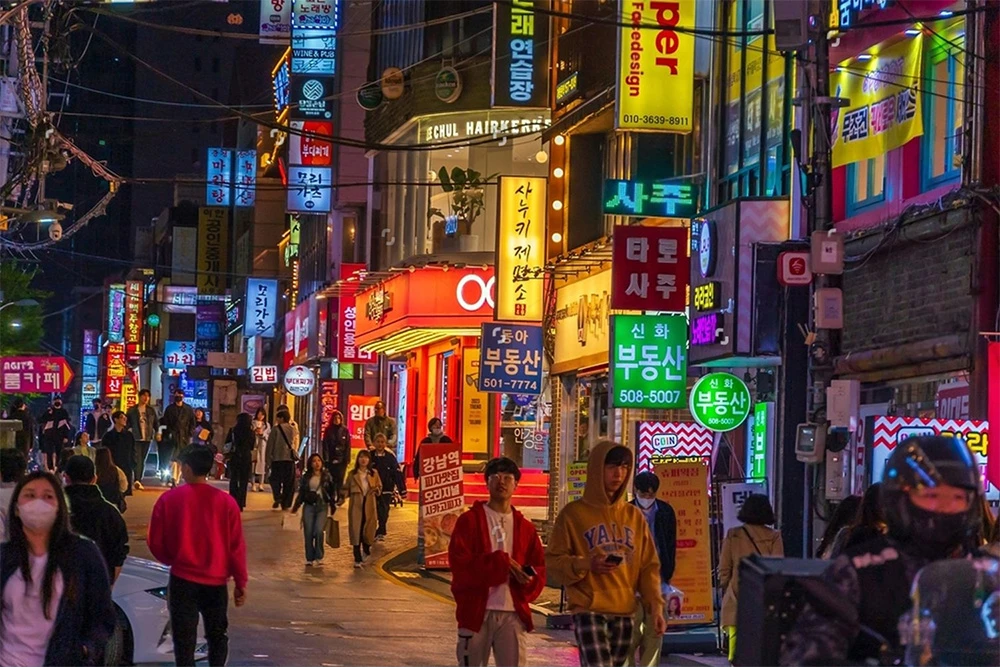
When a bridge throws rainbows into the night
I didn’t expect a commute to feel like a small festival. Then Banpo Bridge let loose its long, lit fountains rainbow after rainbow painting the dark water while the city seemed to take a breath.
Someone told me it’s the longest bridge fountain on the planet, and I believed it as those arcs kept unspooling farther than my eyes guessed. On some evenings the fading mist catches the moon, and the bridge puts on an impromptu water show for whoever’s moving drivers passing through light and night cyclists with damp sleeves. I remember feeling oddly cared for, the ordinary road transformed into a soft reminder that even routine can surprise you.
Neon hideouts tucked behind vending machines and fridge doors
I remember laughing at a vending machine that seemed a little too proud of itself. In Euljiro, doors love costumes clattering dispensers and unassuming fridge fronts playing it cool; behind them waits a small world of low bass, citrus on the air, and the gentle gleam of bottles lined like glassy planets.
The hush is part of the fun, a shared wink among trendy locals, but it never lasts; neon leaks like gossip and soon the room softens with new arrivals. I like how these spots reward curiosity more than confidence, how a city teaches you to look twice and hear the hum behind the hum. It feels like a quiet kind of belonging strangers leaning closer, voices mellowed by colored light as if secrecy is just the doorway to being tender with each other.
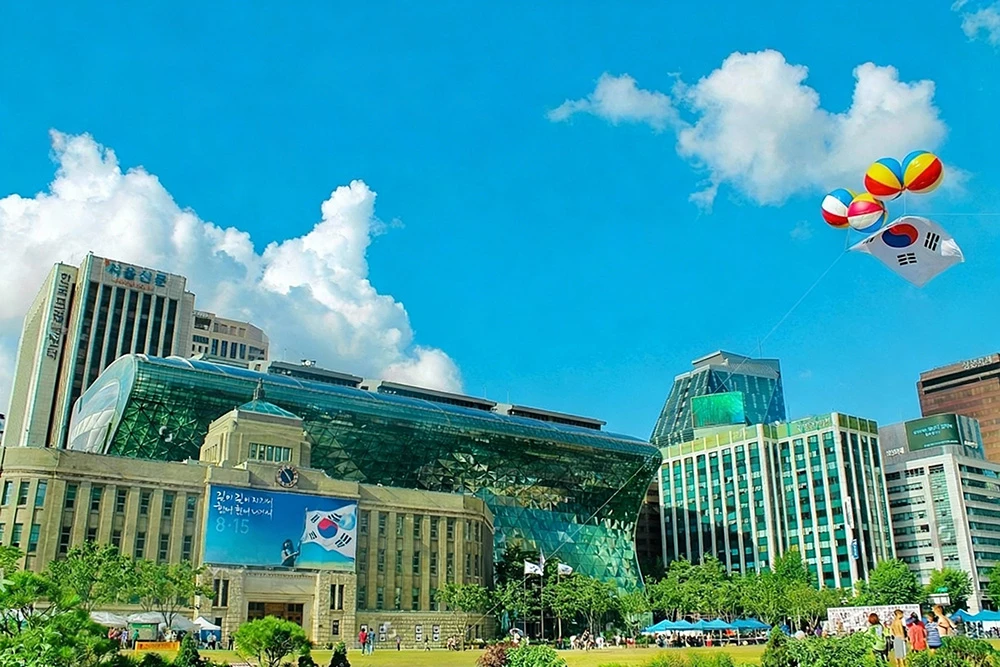
Dress like a star and borrow some youth.
I didn’t expect fabric to hold so much memory, but that crisp blazer and neat ribbon had a way of softening the day. I remember the faint starch against my collar and the easy bounce in my step, the sidewalks humming with bubblegum laughter and neon just waking from its nap. In Seoul, even noon can feel like a soft spotlight, the kind that makes strangers smile at you as if they recognize your theme song.
Renting a school uniform here isn’t really about pretending; it’s a playful nod to a place that adores style and loves to look back with a grin. For a little while you become the lead in a familiar daydream part idol, part drama extra and the city plays along, turning into a runway and a memory lane at once. It’s sweet how it lifts the spirit: the bus chime seems brighter, the steam from tteokbokki stalls wraps around you, and you realize the costume isn’t hiding you at all it’s just letting a younger, shinier version of you step forward.
Bae Ho, golden crooner of Samgakji Station
I didn’t expect a crooner to greet me underground. Yet there he is, all gold and gentle smile at Samgakji Station Bae Ho, Korea’s own Elvis holding steady in the hum of turnstiles. The fluorescent lights give him a soft glow, and for a breath the announcements seem to hush, as if the platform is remembering a slow dance.
I remember his songs drifting from old karaoke rooms, those grainy speakers turning the air sweet and a little sad; even people who claim they don’t know the words still end up humming the chorus. Only in Seoul would a subway platform keep a star shining like a gold note pinned to the transit map, a small bow to the past in the middle of the rush. It made me smile to think the city lets those 1960s heartbeats ride along with us, steady as a melody you can’t quite forget.
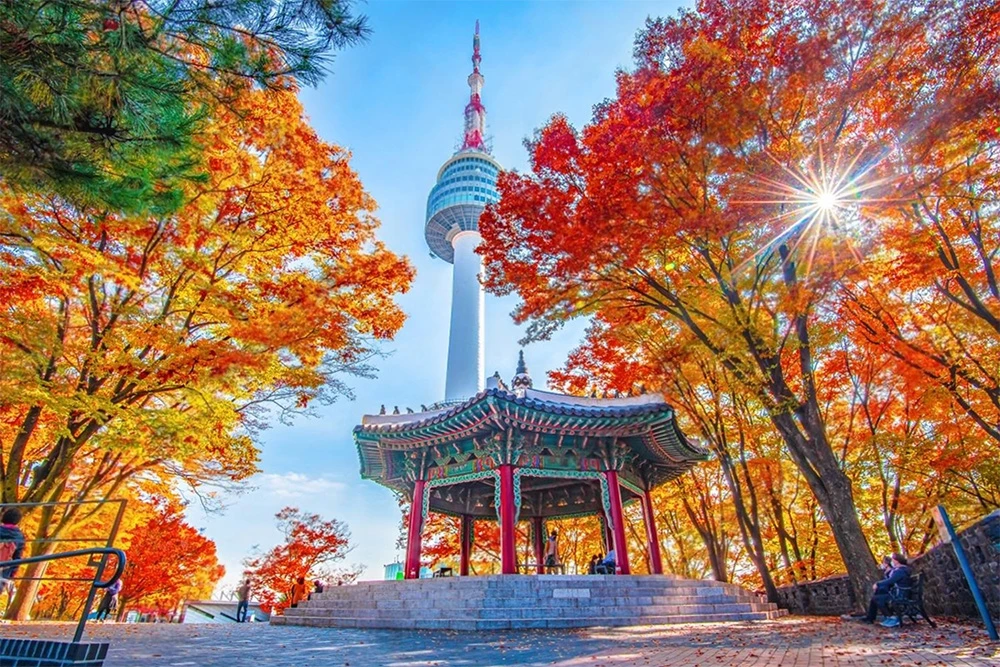
Giant bears guard Seoul’s bright K Pop heart.
I didn’t expect to grin at statues, but there they were: twenty larger than life bears, glossy and bright, each painted to honor a favorite band or performer. On K Star Road in Seoul, the air carries snatches of choruses from passing speakers, and the colors glow in the late sun.
Fans drift by in clusters, pointing, whispering, trading inside jokes; strangers become conspirators for a heartbeat when they recognize the same name. The bears feel like playful bodyguards, standing watch over all that devotion, and the whole strip turns into a mixtape you can walk. I found myself humming to songs I only half know, the kind that tug at you anyway.
Once, I paused at a bear in soft pastels and thought about how public love looks visible, sturdy, a little silly and somehow even more beautiful for it. That was the surprise: a street that makes fandom belong out loud. I left with a lighter step and a tune that refused to leave, the kind you keep without noticing.

From screens to shelves: the Mukbang kit craze
I laughed the first time I saw a ramen pack that big. The aisle hummed softly, plastic crinkling like a promise, and I could almost smell the broth and chili waiting behind the seal. In Seoul, the convenience store felt like a little theater for appetite, bright lights reflecting off cups so oversized you instinctively check if your courage is oversized too.
Mukbang made it all feel inevitable watch enough people eat online and the shelves start to mirror the screen. Now tourists wander in asking for “Mukbang kits,” inspired by YouTube stars, chasing that bold, joyful spectacle: mega noodles, extra heat, the whole setup that invites you to lean in and slurp without apology. I love how it turns a solo snack into company, a dare wrapped in cellophane, proof that even a midnight meal can feel like belonging.
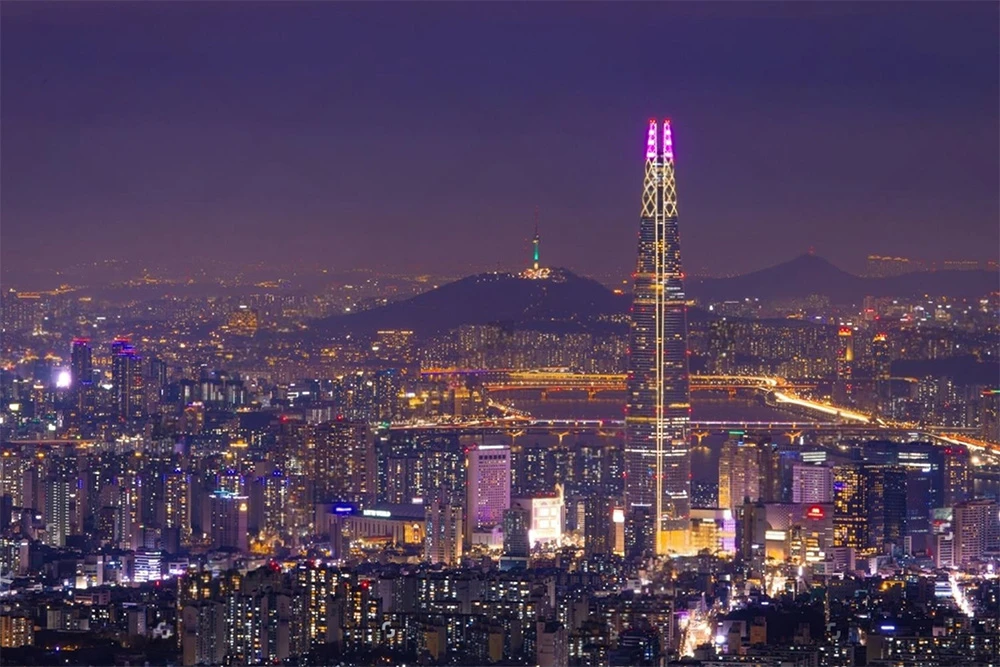
A floating café where study dreams meet the river
I grinned at the lifejackets hanging beside the milk pitchers so matter of fact next to foam and cinnamon. Through the glass walls, the water flickered slate and silver, and the whole place seemed to breathe with it. The floor felt steady, but you could sense the gentle sway beneath everything, a soft reminder that we were on the water, not beside it.
By the windows, students quietly negotiated for the river view seats, notebooks opening like small doors to brighter rooms. Laptops hummed, highlighters left neon commas, and the espresso machine kept time in warm, steady bursts. It might be the prettiest place to study in Seoul, a small ship of quiet ambition held still by anchors you can’t see.
What surprised me most was how the lifejackets changed the mood. They made the scene tender and practical at once the city’s rush held at bay by the simple promise of care. You sip something warm, the light quivers on your table, and work feels gentler, as if the water beneath you is lending its calm to whatever you’re trying to learn.
Pastel Europe outside Seoul, charmingly unreal and quirky.
I remember walking into Petite France and the nearby Italian Village and feeling the ground shift, like stepping onto a film set between scenes. Facades the color of macarons, shutters too perfect, cobbles that never seem to stain; the air smells of sugar and coffee while an accordion hums from hidden speakers. It’s pretty in a deliberate way, lit by a calm, clean sky.
Nothing here pretends to be old or authentic; it’s make believe with a wink, and that’s the charm. Even in Seoul, famous for its quirks, these little “villages” feel surreal more pastel dream than passport stamp and somehow that honesty feels gentle. I left thinking that travel can also be about a mood you share for an afternoon, the brief permission to be lighthearted together.
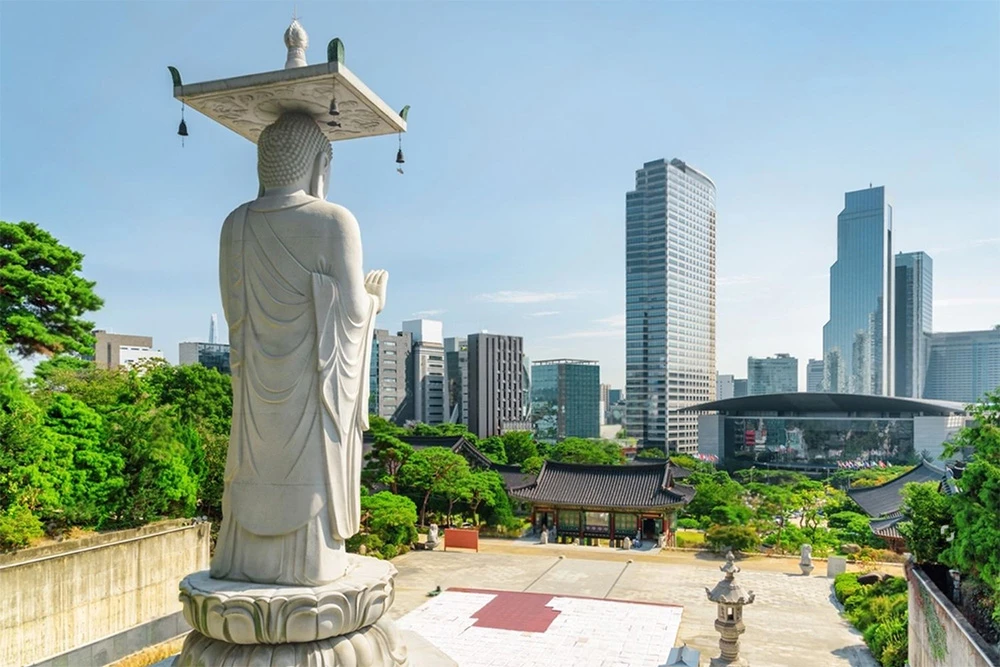
A floating library inside Asia’s largest underground mall
It still surprises me how the loudest streets can hide such a soft hush. Beneath Seoul’s bright rush, inside COEX Mall, the shelves of its library seem to hover – tall, honey lit towers gathering the day’s scattered attention. You hear the low murmur of shoppers thinning into whispers, the soft shuffle of pages, a trace of coffee in the air; and then that pause, a hush like a held breath.
What I love is the generosity of it: Asia’s largest underground mall choosing to make room for wonder. I remember standing there, feeling small in the best way as the books rose around me like trees of light, and the bustle above shrank to a distant hum. It reminded me that even in the busiest places, there’s space to breathe and let your thoughts settle. I left feeling steadier, carrying a small, unexpected calm up into the noise.

Lemon highballs that shook Seoul’s cocktail imagination
I still smile at how a humble convenience store drink set off a citywide fizz. In Seoul, the first sip came with a soft hiss, lemon perfume catching under the neon, and it felt like everything around us was suddenly buzzing like a soda can just cracked open.
Those lemon slice highballs – bright, cheap, perfectly effervescent – kept selling out across the country. The ice chimed, the citrus oils lit up the air, and the little suns of lemon drifted in plastic cups, clean and bright. Friends compared favorites, shelves emptied, and for a moment the whole place seemed tuned to the same cheerful frequency.
And the funny part? The bars followed. Menus turned playful and bold, chasing that same sense of instant delight, as if a drink could be a dare and a wink at once. I loved that it gave everyone permission to feel a bit fancy for spare change. It reminded me that good ideas can start anywhere, even under fluorescent lights.
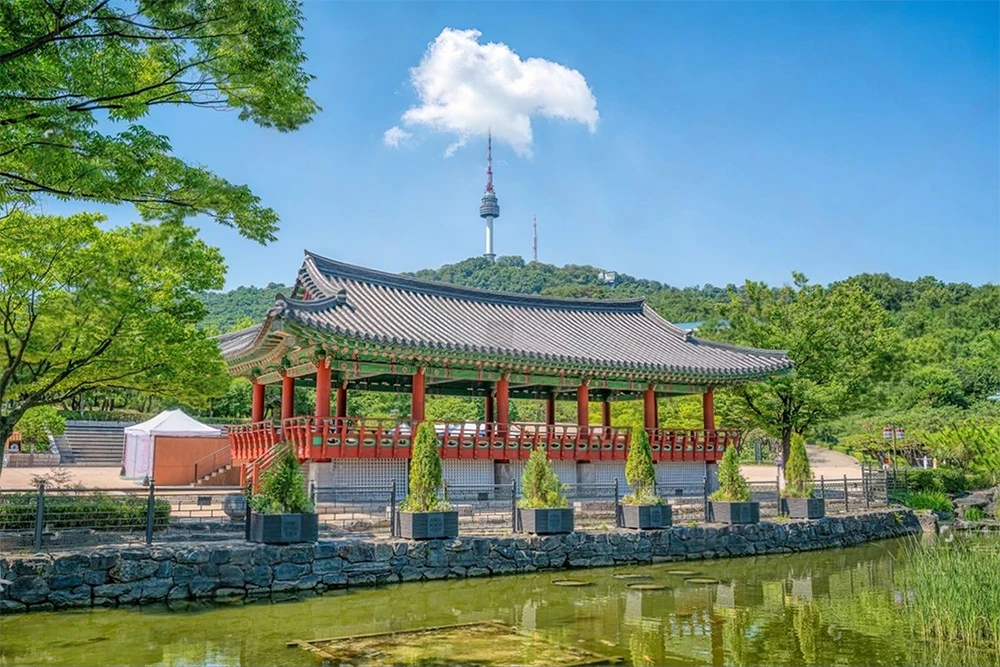
Peering North, Pocketing Paper, Laughing by the Bridge
I remember the hush around the telescopes, the way strangers took turns holding their breath. The wind nipped at our ears at the Korean Demilitarized Zone, and the metal eyepiece was cold against my cheek as distant hills swam into view. It felt like pressing your eye to a keyhole between two stubborn rooms close enough to see shapes, far from touching any of them.
Then the strangeness softened into something human: stacks of North Korean bills for sale at the souvenir stand, thin pastel paper with careful numbers and faces. I turned one in my hand and thought how currency is really a story of daily life milk bought, buses taken, birthdays celebrated and how odd it is to carry that story home as a keepsake. At the Bridge of No Return, guides leaned into playful photos with those cartoon soldier statues, and I caught myself smiling; their jokes were a small kindness to everyone’s nerves. In a place built on stalemate and careful lines, that little ripple of laughter felt like proof that people can still meet each other in the middle.
When Parks Turn Into Gentle Urban Safaris
I love how an ordinary path can surprise you with a quiet grin. One minute you’re following the curve of a lawn, the next you’re meeting a wool white sheep with a calm, sculpted stare, or catching a pair of rabbits huddled like gossiping friends under a tree. Then there’s the giant gorilla, oddly tender despite its size, looming over reeds as sunlight slicks its resin skin. The air smells of cut grass and street food drifting from somewhere beyond the fence, and you can hear a child’s laugh ricochet off the statues as if they’re in on the joke.
That’s what I adore about Seoul: it slips wonder into the middle of your day without asking for permission. These pop up creatures turn a simple walk into a pocket sized safari, reminding me to look up, soften my pace, and let whimsy take the lead for a block or two. It feels like the city giving you a quick wink, a small, playful nudge that says even concrete has room for imagination.
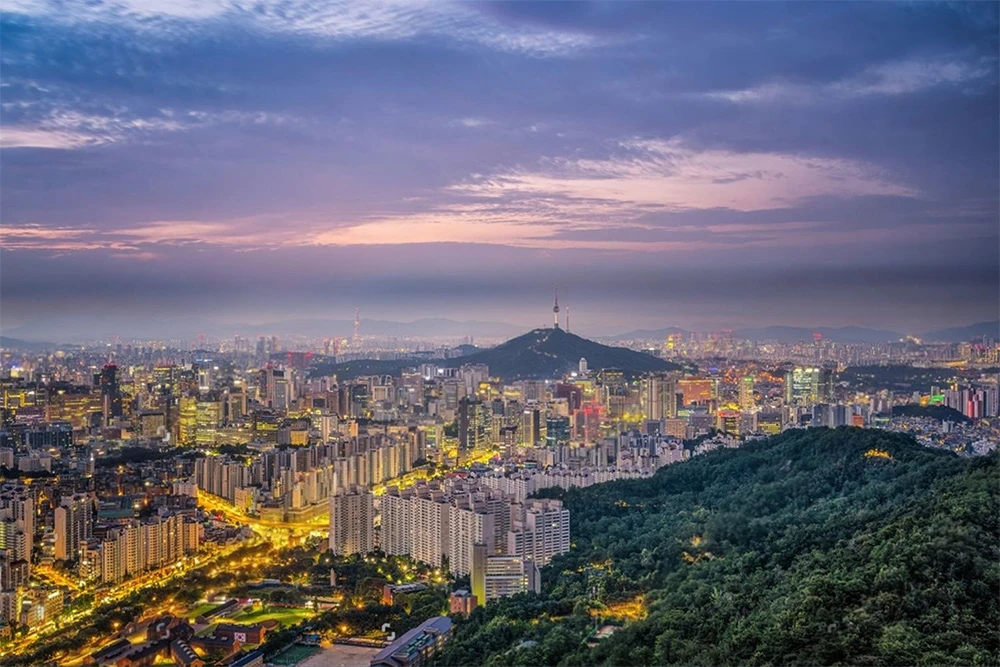
Cartoon giants and wholesale wonders on Toy Street
It’s impossible not to grin when cartoon giants loom overhead, glossy eyes catching the neon. On Dongdaemun’s Toy Street, statues as tall as the shopfronts line the curb, and the air smells faintly of vinyl and sweet batter from nearby stalls. It feels a little like walking through a childhood daydream that decided to rent a storefront.
Hundreds of wholesalers pack the blocks with every universe of play model kits, retro robots, piles of plush price tags fluttering with numbers slashed in bright marker. Voices rise and fall, collectors speaking in quiet codes, model names traded like inside jokes; it’s a stock exchange of joy where the currency is memory. I love how business hums at full tilt yet everything is softened by wonder proof that even a no nonsense market can make you feel eight years old again.

A city built on astonishing internet speed
I remember blinking at how fast everything answered. Lights warmed as I stepped inside, blinds opened to the pale morning, and the bus sign down the street seemed to know what I needed to hear. The whole place moved with an easy rhythm, as natural as fresh air slipping through a window, so the digital faded into the background and life felt oddly lighter.
In Seoul, world leading internet speeds and near universal broadband haven’t made the city colder; they’ve turned it into a smart city many others quietly study. Homes are softly automated, streets share their own small intelligence, and the network hums like a river of data everyone can sip from. I loved the sense that the future wasn’t a spectacle, just everyday kindness technology holding the door, not demanding a round of applause.
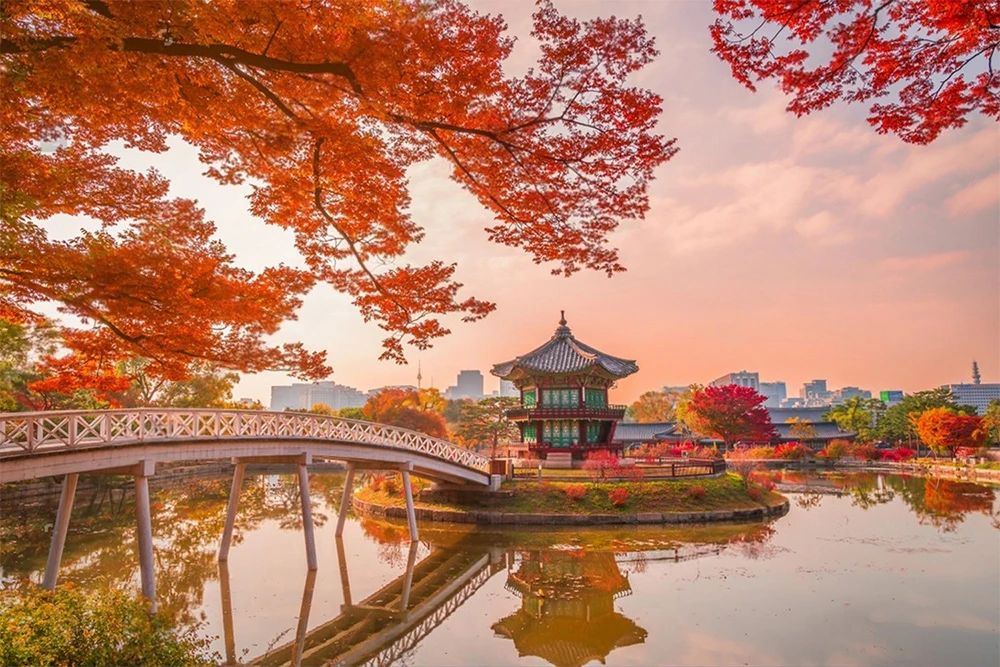
Winter turns the city into joyful ice.
It always makes me smile that the calendar only grants about twenty eight snowy days a year, yet winter here feels endless in the best way. As the air crispens, the rivers button up into glass and parks fill with pop up rinks circled by bright stalls. Steam curls from fish cake broth, sweet hotteok sizzles, and the air smells faintly of roasted chestnuts and cold metal. Blades whisper over the ice, mittens thud gently against the rails, and the night feels unusually clear.
I remember warming my hands around a paper cup, cheeks tingling, watching strangers steady one another as if they’d known each other for years. Kids with red noses zigzag while aunties laugh at the edges; couples wobble and then glow when they find their rhythm, and a vendor presses extra syrup into a pancake with a conspiratorial smile. In Seoul, winter becomes a neighborhood festival stitched with scarves a reminder that scarcity can make joy shine brighter, and that a city can choose to be tender even in the cold.
Breakdancing turns public squares into joyous, acrobatic parties
I remember edging into a loose circle as the evening air carried a little spice from nearby carts. The beat rolled like distant thunder in sneakers, and then the bodies started to fly spins tightening, freezes clicking into place, palms slapping the tiles in time. A grandpa in a cap nodded like he’d seen it all before; a kid in a bright beanie grinned so hard his cheeks glowed. For a minute, the square felt as if it had sprouted wings.
In Seoul, breakdancing takes over the main squares, and the world shows up. Crews from far off cities trade windmills and wit under open sky, judges lean forward on temporary risers, and the claps and shouts keep perfect time. It feels both precise and playful, a kind of pride you can hear in bass and breath, and it surprised me how quickly the plaza became an acrobatic party where everyone especially the strangers felt welcome.
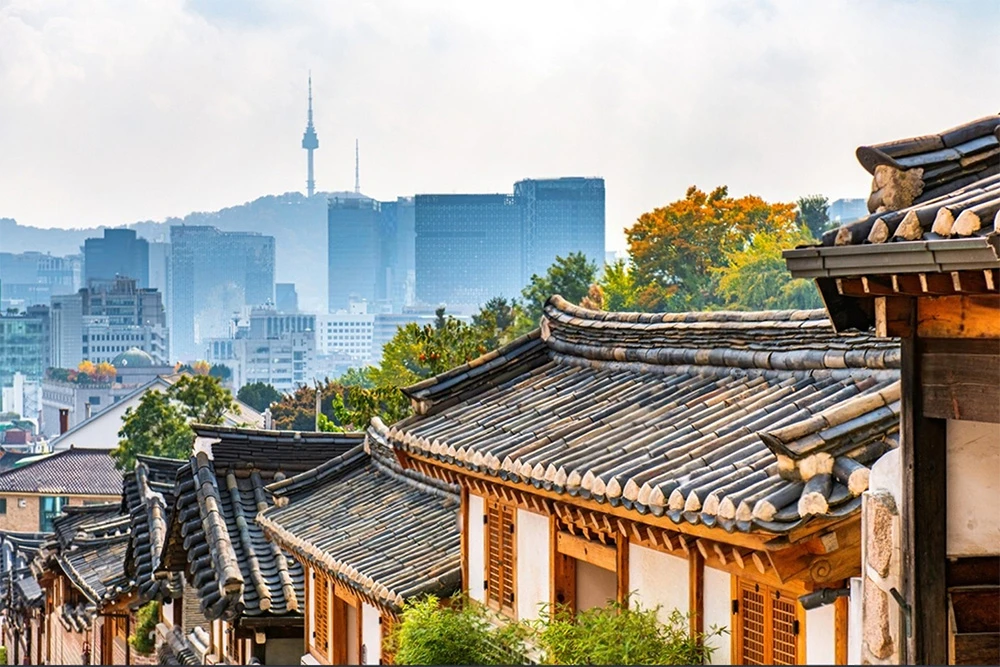
Kindness baked into the bill, no tip needed
It threw me a little at first that old reflex to tip flickering out like a match in daylight. In Seoul, the service arrives already warm and complete: a soft chorus of clinking cups, metal chopsticks cool against the fingers, a quiet refill appearing just when the tea runs low. Sometimes there’s an extra side dish, a tiny sweet at the end, or that friendly wave that says, don’t worry, you’re already cared for. Tipping here doesn’t just feel unnecessary; it can feel awkward, like speaking too loudly in a room that’s already perfectly tuned.
What I love is how the generosity lands without fanfare, as natural as breathing. The kindness isn’t a performance; it’s a craft, something people take pride in the way you’d welcome a friend to your own table. I remember leaving a café with the faint scent of citrus on my hands and the sense that the bill wasn’t the end of the story only the practical part. The real currency is the small, unasked for gestures, a quiet hospitality that glows from the inside, like a light left on for you before you even know you’ll be late.
Twice New York’s density, yet mountains breathe between alleys
Funny how a place can feel like a whisper even when it ought to be a shout. They say the crowding here is nearly twice New York’s and eight times Rome’s, and yet in the tightest alleys the air still carries cool threads from the river and a faraway hint of granite ridges. Steam from food stalls curls up with the hum of neon, and then, between buildings, a sudden wedge of blue. It’s the contrast that gets me – all that density, but the edges of nature always brushing your sleeve.
I remember the street thick with voices, and above the roofs the mountains leaning in like quiet elders, reminding everyone to breathe. In Seoul, the crush never feels cruel; it’s more like a heartbeat, steady and human, making room for small kindnesses, a shared umbrella, a nod in passing. Maybe that’s the surprise – that a city so full can still feel spacious in spirit, the kind of place where you look up and find a piece of sky reserved just for you.

When the city keeps the lights on for you
I love how the night here never feels like an afterthought. There’s steam pooling in warm corners and the soft rustle of paper, the kind of hush that lets you hear your own thoughts. I remember the comfort of knowing that, at midnight or four, somewhere a door is open, the tile is warm, and the air smells faintly of eucalyptus and toasted seaweed.
Bathhouses glow through the small hours while study rooms wear their steady, fluorescent halo. Night owls drift between a soak and a stack of notes; ambitious hearts outline tomorrow’s dreams with pencil scratches, breaking only for a bowl of broth or a sweet rice triangle. The city hums like a late night radio steady, unhurried, tuned to the people who need the extra hours.
What gets me is how tender that feels. It isn’t just a refusal to sleep; it’s permission, a gentle nod that says keep going or rest a little longer, whichever you need. In Seoul, the clock stretches with you, and the night stops being a wall and becomes a companion quiet, kind, and miraculously awake.
Twenty five districts, each with its own character
Some days it felt like the city kept changing jackets every few blocks. There are 25 districts here, each with its own local government and a look that insists on being itself – from the polished glow of Gangnam’s boulevards to the indie alleyways of Hongdae, inked with posters and the smell of coffee and paint.
I remember stepping out into Gangnam one evening: high heels clicked, engines purred, glass gleamed. Later that night in Hongdae, the bass was looser, posters curled at the edges, and a kid with purple hair laughed into the steam drifting from a paper cup of ramen.
What surprised me is how official it all is – each with its own district office and duties, like neighbors hosting their own dinner parties – and still, moving from one to the next is effortless. Say Seoul once and you mean all of it: the glitter, the grit, and the quiet alleys where the air cools your cheeks.
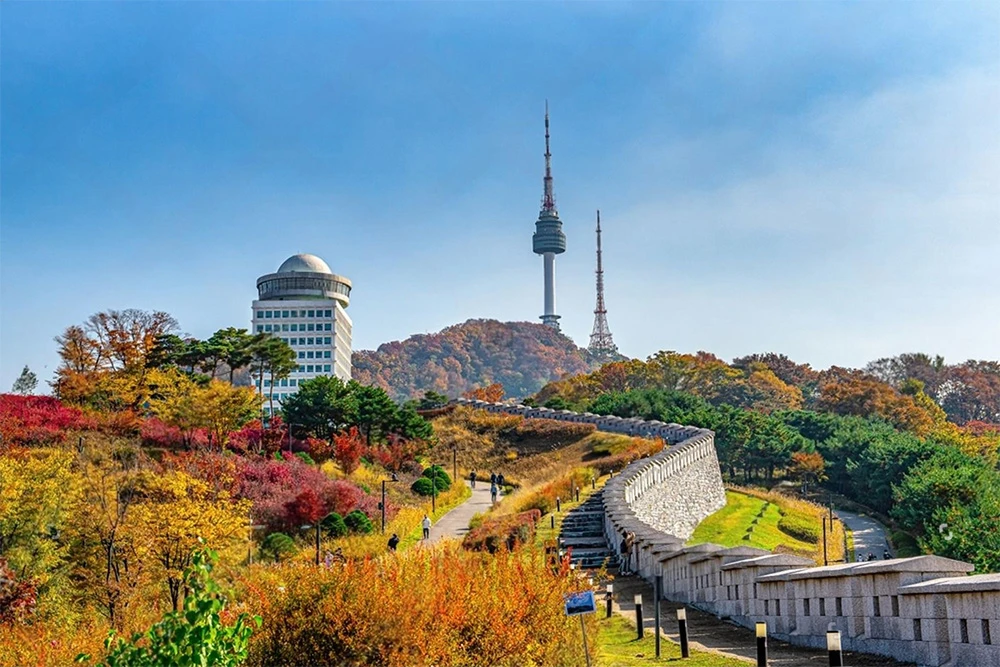
Alleys devoted to one craving at a time
I love when a city admits that hunger changes with the hour. In Seoul, entire blocks promise just one thing tteokbokki steam staining the air a soft red, the sauce sweet then fierce against your lips; a street where the crackle of hot oil and garlic means fried chicken is king; a bend where beondegi simmer and give off that nutty, earthy hush. Each block feels like a little vow to one flavor, and somehow that makes choosing simple and strangely joyful.
I remember picking a lane by mood and weather: on chilly nights the chicken’s crisp warmth felt like a small rescue; on restless evenings the rice cakes were a drumbeat, chewy and comforting beneath their peppery shine. Once, a vendor pressed a toothpick of silkworm larvae into my palm nutty, a bit brothy, like chestnuts after rain and I felt this soft flicker of pride, the kind that comes when you greet a new taste without flinching.
There’s a tenderness in a place that organizes itself around desire: no arguments, no indecision, just follow your curiosity and let it feed you. Adventurous palates aren’t shouted about there; they’re quietly welcomed, rewarded with bowls that feel like permission proof that sometimes the most generous kind of choice is the one made for you, one delicious alley at a time.
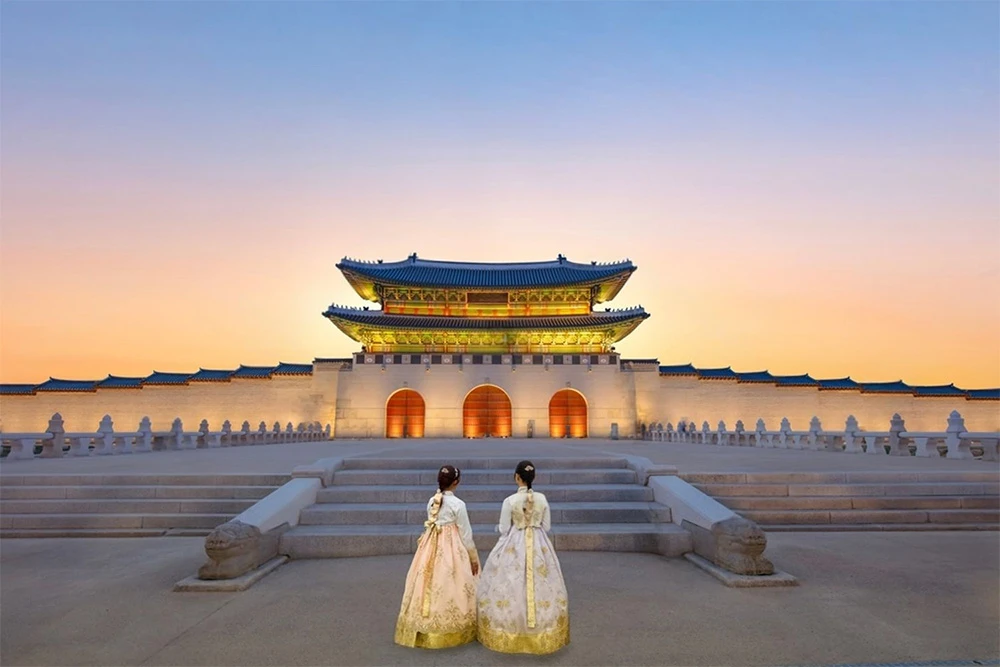
A district built for stories, pixels, and pop dreams
I remember how the light felt the glass towers catching late sun while LED facades sent a soft wash of color across the plaza. In Seoul’s Digital Media City, the air carries a bright electric hum, and it feels a little like stepping inside a live storyboard.
What gets me is that an entire neighborhood exists just for what we imagine: film, gaming, broadcasting, and art under the same sky. Fueled by South Korea’s pop culture boom, the place moves with momentum; snippets of music drift from rehearsal rooms, the low thrum of servers rides the elevator shafts, and warm coffee steam folds into morning as editors and coders trade ideas.
Being there, I felt both fan and co conspirator, like the city had given me permission to dream in higher resolution. It’s surprising and kind of beautiful that the future here doesn’t feel cold at all because everything is about people and the stories they make, and you can sense that energy settling right under your skin.
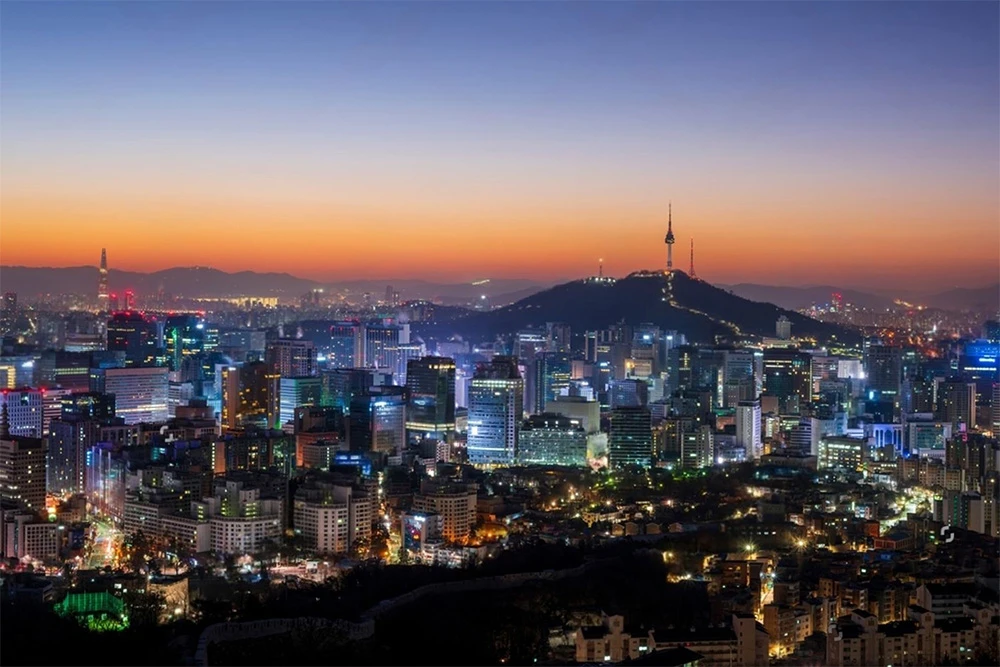
Six dollar basements that fuel all night quiet focus
Some nights, when the world feels too loud, the quiet is waiting underground. For about six dollars a day, you get a desk, an outlet, and that gentle promise of free coffee or little snacks enough to steady the edges. The air hums softly, desk lamps glow like patient moons, and the shuffle of notes becomes its own kind of comfort. It feels like a secret everyone knows, a small lighthouse for the tired mind.
I remember in Seoul, the hours softened in one of these study rooms, as if time put a hand on my shoulder and told me to take what I needed. Around me were strangers who felt familiar: late night learners with steady eyes and small hopes, sharing the hush and the caffeine. There’s something tender about a city that leaves a warm cup and a cookie at the door of your concentration like a blanket for your thoughts, and permission to keep going.
Directions here mix apps and local wisdom
I remember a neon soft evening when my phone blinked in polite confusion. Because of local law, some Google services Maps included keep a respectful distance, so directions often come as a blend of Korean apps and the kind of creative advice shared by a fruit seller or a student beside you. In Seoul, it feels oddly tender, like the city is teaching you its shortcuts by hand.
At first it’s surprising, then comforting the city becomes a conversation, not a diagram. You start to notice quieter cues: the subway chime floating up from the stairs, broth steam curling from a street cart, a bakery’s sweet air marking the corner you need. Travel shifts from trusting a single screen to trusting the neighborhood, and somehow the way there feels more human.
A city cradled by eight quiet mountains
It still surprises me how, after just a few stops, the skyline gives way to a whisper of pines and the soft grit of stone underfoot. I remember noticing office shoes quietly traded for trail shoes, like the workday and the hillside shaking hands. The air turns a little cleaner on those paths cicadas humming, leaves brushing shoulders, the city’s noise thinning until it sounds polite, almost far away.
All of this hides in plain sight because within Seoul’s limits there are over a hundred parks, gathered inside a ring of eight mountains. That’s why slipping into green isn’t a special occasion here; it’s a daily ritual, something small and steady people keep before dinner or at dawn. I love how it shapes the spirit of the place ambitious in its rush, yet softened by the knowledge that a bench, a breeze, and a view are never more than a short step away.
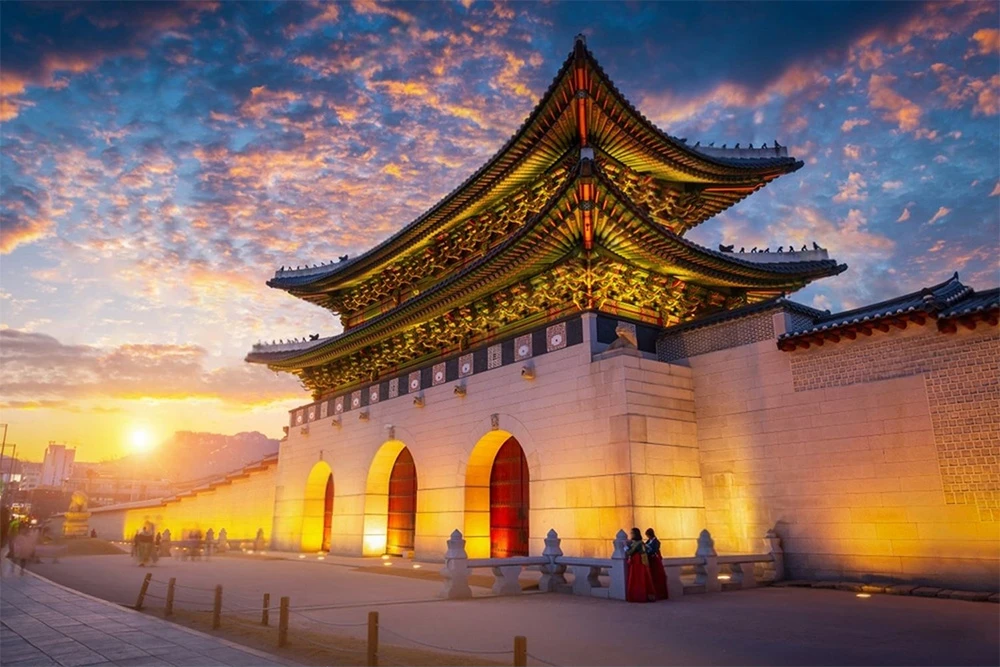
Final thought
In the hidden stories, the small details, and the human moments that soften a busy day, the city reveals something closer to the truth. Seoul comes into focus not through grand gestures, but in a shared laugh, a careful sign, a doorway left open to the afternoon. All of it gathers like a lantern quietly rekindled at dusk, casting just enough light to guide your steps. Keep noticing, and let that gentle truth shape the way you wander onward, inspired.

